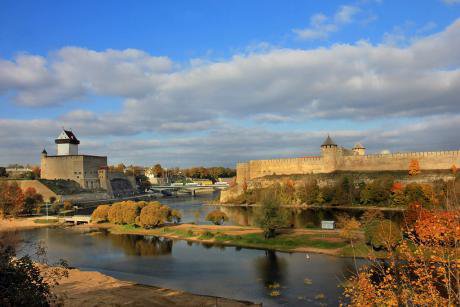
View of Narva Castle and Ivangorod Fortress. Photo CC BY-SA 4.0: Aleksander Kaasik / Wikimedia Commons.Narva lies on the easternmost edge of Estonia, on the Narva river, right by its border with Russia. Indeed, the Russian town of Ivangorod lies across the river. The results of municipal elections in town have shown that most local people have no desire for change. But one Russian pensioner who tried to take his own life by setting himself on fire was a reminder that not everyone was happy with the results.
On 15 October, Estonians went to the polls to elect new municipal governments. In Ida-Viruuma, a border region with Narva at its centre, a place where more than 80% of residents are ethnic Russians, Estonia’s Center Party retained its majority in the local council, winning 23 out of 31 seats. There was nothing unexpected in either its victory or the traditionally low (46.7%) local voter turnout.
The day, however, didn’t pass without incident. An elderly man, thought to be a Russian citizen, tried to set himself alight in the city’s central Petrovsky Square in protest at Estonian government politics. He managed to douse himself with petrol and use his cigarette lighter, but police officers swiftly put out the fire and he was not seriously hurt.
For Narva this was an extraordinary event. Back in the early 1990s, certain sections of the Russian population of Ida-Viruuma dreamed of establishing an autonomous "Narva Republic", but for the last few years life here has been quiet. The older generation discusses its problems in its kitchens while younger people, who have grown up in the EU, are busy getting educated and moving to Tallinn or another European capital.
In the shadow of Estonia’s last Lenin statue
You can travel from St Petersburg to Narva by direct train or bus, but it’s a boring journey. It’s more interesting to buy a ticket to Ivangorod, on the other bank of the river, and see the difference between the two halves of a city divided by the river that forms the border between Estonia and Russia. Ivangorod has roads full of potholes, smashed street lights and a path between bushes leading to the grass-surrounded old customs post. Your first impression of Narva, on the other hand, will be of smooth, clean roads, a new customs building and well-lit streets. Only overhearing Russian hits of the 1990s by bands such as Rukhi Vverkh (“Hands Up”) and Demo might remind you that we are in the most Russian city of Estonia, and indeed the entire EU.
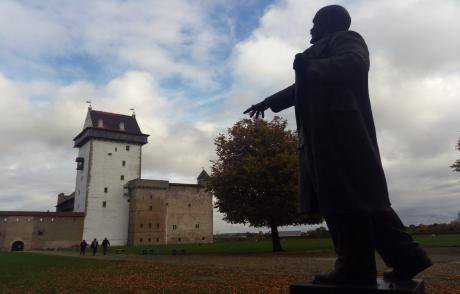
The last undestroyed statue of Lenin in Estonia on the territory of the Narva Castle. Photo courtesy of the author. All rights reserved.In the first light of dawn, no doubts remain. The rows of five storey housing blocks once ubiquitous throughout the USSR remind you that Russia is close. This Khrushchev-era innovative architecture stands next to a 17th century town hall, but a statue of Lenin, the last in Estonia, can still be seen inside the even older Narva Castle. It was moved here from the city’s central square a few years ago, so that Ilyich, as Lenin was popularly known, could hide from the tourists, his arm stretched out towards Russia, on the other bank of the river. Whether he yearns to go there, or is just calling for help, is unclear.
As you stroll through its streets, you can’t stop wondering how this place regularly finds itself at the centre of geopolitical scandals
This city, the third largest in Estonia and an outpost of the “Russian World” on the Baltic Sea, is small and quiet. As you stroll through its streets, you can’t stop wondering how this place regularly finds itself at the centre of geopolitical scandals.
When Russia annexed Crimea in 2014, and the Ukrainian government countered with its Anti-Terrorist Operation in south-east Ukraine, Narva was inundated with journalists from both the Russian and western media. Armed forces flexed their muscles on opposite sides of the border: first there was NATO carrying out exercises and then, on the other bank of the Narva River, the Russian Army followed suit. But the special correspondents, after gauging the mood of the local population, sent very similar reports back to their countries: this won’t be another Donbas — people here like Russia, but no one wants a war.
Vladimir Izotov, a deputy of Narva’s city council, had to spend a lot of time answering western correspondents’ questions about whether Narva would be a second Crimea, citing himself as an example of the ethnic Russians’ loyalty to the Estonian state. Being Russian, he could be successful in both politics and business, and could even make speeches at council meetings in his own language without any problems.
“The news from Estonia doesn’t always reflect the opinions of either the government or the local people,” Izotov tells me. “The news agenda is often set by Estonian nationalists, who have only 10% of seats in parliament. They are always thinking up populist slogans about things like removing the vote from non-citizens, and the media feed off them hungrily in search of sensations. But I can tell you for sure that 99% of Narva’s population has no interest in leaving Estonia. They have enough problems.”
This won’t be another Donbas — people here like Russia, but no one wants a war
The nationalists in question are the Conservative People’s Party of Estonia (Eesti Konservativne Rahvaerakond, EKRE). This party is both anti-Russia and critical of integration in the EU, and in particular of the government’s lack of legislative independence.

Estonia's ruling Center Party won Sunday's local election in what has been seen as a key test for Prime Minister Juri Ratas, whose party split into two factions in 2016. (c) Guo Chunju/Xinhua News Agency/PA Images. All rights reserved. The radical conservatives have seven seats in the national parliament, but neither they nor other nationalist parties took part in the municipal election, as there was no point. The only political forces that have any traction here are those that promise to support the Russian-speaking population: the Centre Party has traditionally done well here, as has the main opposition party, the Our Narva electoral alliance, one of whose central slogans is, “Narva is also Estonia.”
A Narva Republic?
The first post-Soviet years in Ida-Viruuma were marked, to an extent, by burgeoning ideas of revolt. Enthusiasts among the Russian-speaking population nurtured a plan to create a Narva Republic, an autonomous Russophone entity within Estonia, and proposed to give its government the power of veto over laws that would infringe the rights of the ethnic Russian population. The issue came to a head with a referendum held on 16-17 June 1993. The pro-autonomy faction claimed that they won a majority of the votes, but the Estonian government didn’t recognise the referendum and neither did Russia, on whose support the Russian-speakers were counting.
These days, the might-have-been Narva Republic has museum displays devoted to it. Even Estonian nationalists — the people who call for removing the vote from Estonian citizens with Russian or grey “stateless” ID papers and expect Russian aggression at any moment — don’t believe it could ever happen.
“We believe that there might be a Russian invasion anywhere along the border, but the people living in Ida-Viruuma won’t support it”
“We believe that there might be a Russian invasion anywhere along the border, but the people living in Ida-Viruuma won’t support it,” Martin Kummets, of the nationalist Estonian Independence Party (Eesti Iseseisvuspartei, EIP), tells me. “Many of these people have family on the other side, and they know fine well that life is better here. And after all, nobody outside Russia recognises the legitimacy of the referendums in Crimea and Donbas.”
According to Kummets, Russian and Estonian young people are well integrated with one another and ethnic-based conflicts between them never arise. He also believes that his party has supporters among Narva’s Russians.

Narva Town Hall, built in 1671. Photo courtesy of the author. All rights reserved.Alexander Kornilov, head of the Baltiya information project that is the voice of the Russian community in Estonia NGO, is one of the main ideological opponents of Estonia’s radicals. Articles debunking the ultranationalists appear on it alongside news of Russian-language cultural highlights and events honouring Second World War veterans, criticism of the EU and updates on Catalonia’s fight for independence. Kornilov believes that the Estonian government deliberately withholds funding from the Ida-Viruuma region because of its Russian population, and in doing so is making its biggest mistake.
Unlike Estonian patriots, the Russian journalist accepts the possibility of Narva and the area around it breaking away from Estonia: “Anything is possible in our world today – you just have to look at the United Kingdom and Spain. And given central government’s negative attitude to our region, there’s no telling what might happen”.
According to Kummets, Russian and Estonian young people are well integrated with one another and ethnic-based conflicts between them never arise
Figures from Estonia’s Revenue and Customs Department show that in 2016, residents of Narva had the lowest incomes of anyone in the country. Their average monthly salary, pre-tax, was €802 (£715): the average for Estonia as a whole was €1,084 (£967). Ida-Viruuma has also traditionally had the highest unemployment rate in the country: at the end of September 2017 this stood at 9.2%, over twice the national average of 4.5%.
Teens go to the polls
The 2017 elections have been the first in which 16 year olds have been able to vote, after a law was passed last year lowering the age limit for municipal elections. And although most of Narva’s teens have little interest in voting, there are socially active young people who are interested in politics, says Alexey Kupavykh, the Speaker of Narva’s Youth Parliament. This body is elected on the basis of votes cast in schools, and its main job is to organise social events. But the members see their chance to vote at such a young age as a sign of trust in them.
“The people who vote are the ones who have concerns, who have faced problems they can’t deal with on their own,” Alexey tells me. “It doesn’t even matter whether they’re interested in politics or not: it teaches them responsibility. It’s like a leap into adult life.”
Alexey is 17, and this is his last year at school. He is planning to continue his education in Tallinn: it’s a more interesting place for both studying and having a good time, and salaries are higher there too. He does, however, think that he might come back to Narva in the future. He’s happier in his home town than he would be in, say, the more prosperous Tartu, Estonia’s second city.
I listen to his thoughts on his future and ask an awkward question: “Lyosha, you’re an ethnic Russian and you’ve spent the last four years living in the EU. Do you still feel a link with Russia?”
“With Russian culture, yes,” he answers, “But not with the country. It probably sounds rude, but everything’s different there. All those advertising boards on houses and along the roads. You arrive in Russia, and you look at all the run-down villages… and the people are different: sad and bad-tempered.”
Lack of jobs and prospects
Narva is literally dead at night. After eleven o’clock it’s not just a question of no one out on the streets — most of the windows are dark as well. The only things that are open all night are a flower shop and currency exchange kiosks, not to mention casinos where taxi drivers hang around waiting for fares and tipsy punters smoke nervously. I decide to buy some flowers.
Despite the late hour, temporary florist Zlata and her husband Sergey have a customer: a fortyish woman is buying flowers for Teachers’ Day. After she has paid and left, the couple turn their attention to me, and, having quickly realised that I’m not a local, pour out all their stories of woe.
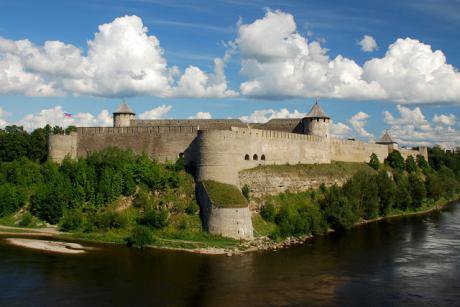
Ivangorod fortress. CC BY-SA 3.0 Simm / Wikimedia Commons. Some rights reserved.Zlata and Sergey are from Ivangorod, and are filling in at the flower shop for Zlata’s sick sister, who owns the shop. It’s no problem for them – home’s just a walk away - but there’s no work in the Russian border town: all the factories have closed down.
“We had so much here before! The fish processing plant was a prestigious place to work, for a start,” says Zlata. “But it all disappeared overnight, and now there are just food shops and pharmacies.”
There is nothing accidental about these types of business — they are targeted exclusively at Ivangorod’s western neighbour, Narva. People come across from Estonia to buy unobtainable medical products, cheap alcohol and cigarettes. And there’s a parallel stream in the other direction, with Russians going to Narva to buy contraband cheese (unavailable in Ivangorod because of international trade sanctions), red salmon and second hand clothing, usually for resale.
There are more and more second hand dealers, or touts, as Zlata calls them, in Narva. After the collapse of the USSR all the factories closed here, just as in Ivangorod, and no new large firms have come to replace them. Sergey may have spent all his life in honest work, but he can understand the touts. Two employers in Ivangorod owe him money – he was working for them on the side, cash in hand. And it’s not easy to find another job, on either side of the river.
“I think the Estonian authorities are ruining Narva,” he says. “You know what I think? In the future there’ll just be a NATO base here, nothing else. That’s all they need the city for.”
When Zlata discovers that I’m a journalist, she tells me her “favourite story” that has to do with fireworks:
“On ‘Ivangorod Day’, they used to have a firework display. But then they switched off the lights in people’s homes, to recoup some of the money it cost. It’ll soon be the New Year; we’re already stocking up on candles, so we’ll be ready. You write about it, try to let President Putin know what’s happening here. The local authority has tarted up some small bits of Ivangorod; they’re taking photos of them and publishing them all over the place, but the whole town’s in ruins.”
The “ruins” of Ivangorod are a walking distance from Narva — a kind of dreadful warning against any attempts at reintegration with the Russian world. The year 2012 saw the start of a project to build promenades along both sides of the river, as part of an EU financed “United by Borders” programme for cross border cooperation. The promenades were opened in February 2014, but much less of the work on the Russian side was completed, and it was noticeably less impressive than on the Estonian side.
The “ruins” of Ivangorod are a walking distance from Narva — a kind of dreadful warning against any attempts at reintegration with the Russian world.
Another story that has turned into folklore on both sides is that of the new customs posts, where building work also started at the same time in both Russia and Estonia. Estonian officials have now been occupying their new buildings for two years, while the Russians are still awaiting their “housewarming.”
In August this year, Rosgranstroi, the body that oversees border construction projects, announced that the two Ivangorod Customs Posts would be in operation by September. It’s now nearly November, and people are still walking along paths between bushes to the old Customs buildings.
It’s issues like this that make the inhabitants of Narva love their country a little more, despite all its problems and disadvantages — even as they have no confidence in the ability of their local government bodies to solve these problems any time soon.
Read more
Get our weekly email

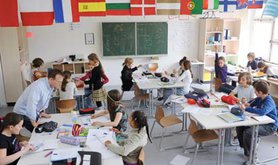
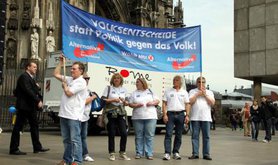
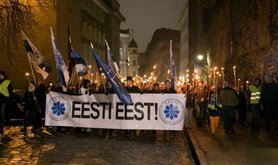

Comments
We encourage anyone to comment, please consult the oD commenting guidelines if you have any questions.